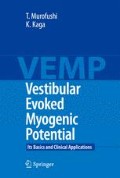Abstract
Tullio first reported that surgical fenestration of the bony labyrinth in avians and mammals made the labyrinth sound-sensitive [1-3]. This phenomenon-sound sensitivity of the vestibular system-has been known as the Tullio phenomenon [3, 4]. Bekesy reported head movements in response to relatively loud sounds [3, 5] and suggested that this effect might be caused by stimulation of the otolith organs.
Access this chapter
Tax calculation will be finalised at checkout
Purchases are for personal use only
Preview
Unable to display preview. Download preview PDF.
References
Tullio P (1929) Das Ohr und die Entstehung der Sprache und Schrift. Urban & Schwarzenberg, Berlin
Minor LB, Solomon D, Zinreich JS, et al (1998) Sound-and/or pressure-induced vertigo due to bone dehiscence of the superior semicircular canal. Acta Otolaryngol Head Neck Surg 124:249–258
Halmagyi GM, Curthoys IS, Colebatch JG, et al (2005) Vestibular responses to sound. Ann NY Acad Sci 1039:54–67
Huizinga E (1935) On the sound reaction of Tullio. Acta Otolaryngol (Stockh) 22:359–369
Bekesy GV (1935) Uber akustische Reizung des Vestibularapparates. Pflugers Arch Ges Physiol Mensch Tiere 236:59–76
Young ED, Fernández C, Goldberg JM (1977) Responses of squirrel monkey vestibular neurons to audio-frequency sound and head vibration. Acta Otolaryngol (Stockh) 84:352–360
Cazals Y, Aran JM, Erre JP (1980) Acoustic responses after total destruction of the cochlear receptor: brainstem and auditory cortex. Science 210:83–86
Cazals Y, Aran JM, Erre JP (1982) Frequency sensitivity and selectivity of acoustically evoked potentials after complete cochlear hair cell destruction. Brain Res 231:197–203
Didier A, Cazal Y (1989) Acoustic responses recorded from the saccular bundle on the eighth nerve of the guinea pig. Hear Res 37:123–128
McCue MP, Guinan JJ (1994) Acoustically responsive fibers in the vestibular nerve of the cat. J Neurosci 14:6058–6070
McCue MP, Guinan JJ (1995) Spontaneous activity and frequency sensitivity of acoustically responsive vestibular afferents in the cat. J Neurophysiol 74:1563–1572
McCue MP, Guinan JJ (1997) Sound-evoked activity in primary afferent neurons of a mammalian vestibular system. Am J Otol 18:355–360
Murofushi T, Curthoys IS, Topple AN, et al (1995) Responses of guinea pig primary vestibular neurons to clicks. Exp Brain Res 103:174–178
Murofushi T, Curthoys IS (1997) Physiological and anatomical study of click-sensitive primary vestibular afferents in the guinea pig. Acta Otolaryngol (Stockh) 117:66–72
Goldberg JF, Lysakowski A, Fernandez C (1992) Structure and function of vestibular nerve fibers in the chinchilla and squirrel monkey. Ann NY Acad Sci 656:92–107.
Murofushi T, Curthoys IS, Gilchrist DP (1996) Response of guinea pig vestibular nucleus neurons to clicks. Exp Brain Res 111:149–152
Curthoys IS, Kim J, McPhedran SK, et al (2006) Bone conducted vibration selectively activates irregular primary otolithic vestibular neurons in the guinea pig. Exp Brain Res 175:256–267
Sheykholeslami K, Murofushi T, Kermany MH, et al (2000) Bone conducted evoked myogenic potentials from the sternocleidomastoid muscle. Acta Otolaryngol (Stockh) 120:731–734
Welgampola MS, Rosengren SM, Halmagyi GM, et al (2003) Vestibular activation by bone conducted sound. J Neurol Neurosurg Psychiatry 74:771–778
Kushiro K, Zakir M, Ogawa Y, et al (1999) Saccular and utricular inputs to sternocleidomastoid motoneurons of decerebrate cat. Exp Brain Res 126:410–416
Colebatch JG, Halmagyi GM, Skuse NF (1994) Myogenic potentials generated by a click-evoked vestibulocollic reflex. J Neurol Neurosurg Psychiatry 57:190–197
Rights and permissions
Copyright information
© 2009 Springer
About this chapter
Cite this chapter
(2009). Sound Sensitivity of the Vestibular End-Organs and Sound-Evoked Vestibulocollic Reflexes in Mammals. In: Vestibular Evoked Myogenic Potential. Springer, Tokyo. https://doi.org/10.1007/978-4-431-85908-6_3
Download citation
DOI: https://doi.org/10.1007/978-4-431-85908-6_3
Publisher Name: Springer, Tokyo
Print ISBN: 978-4-431-85907-9
Online ISBN: 978-4-431-85908-6
eBook Packages: MedicineMedicine (R0)

